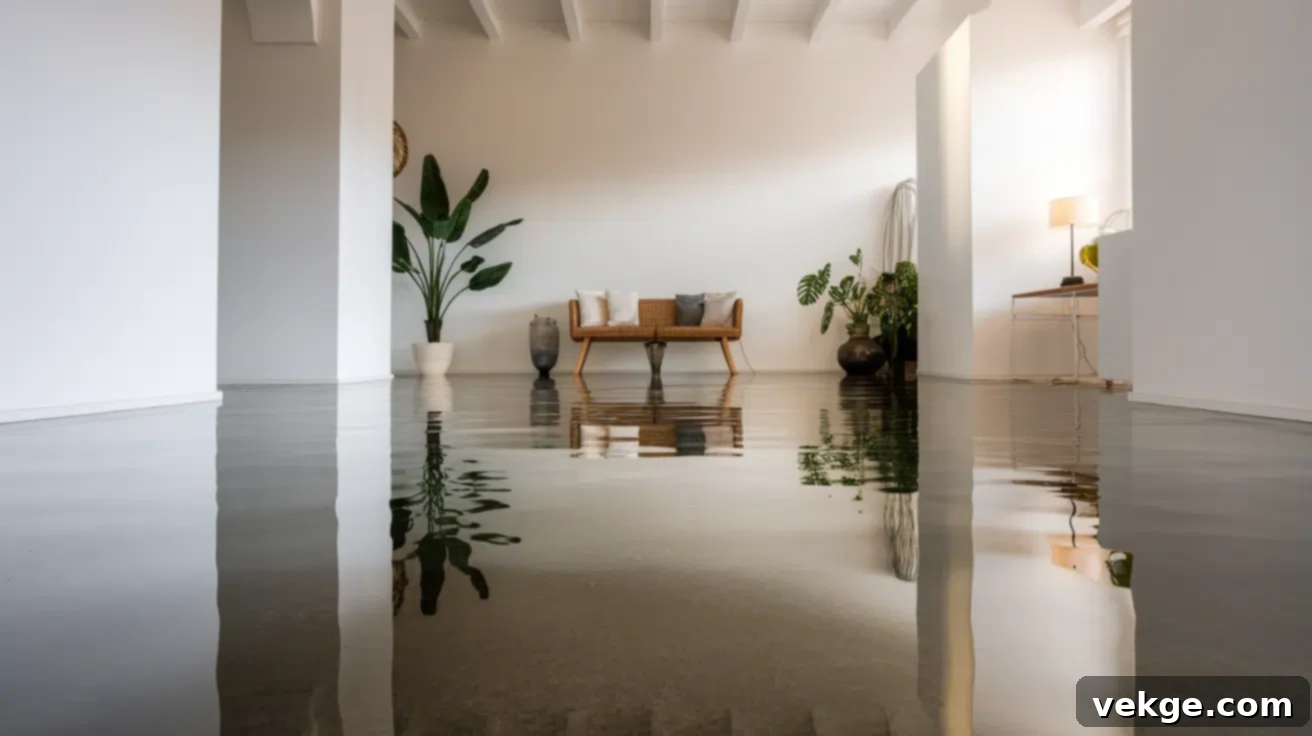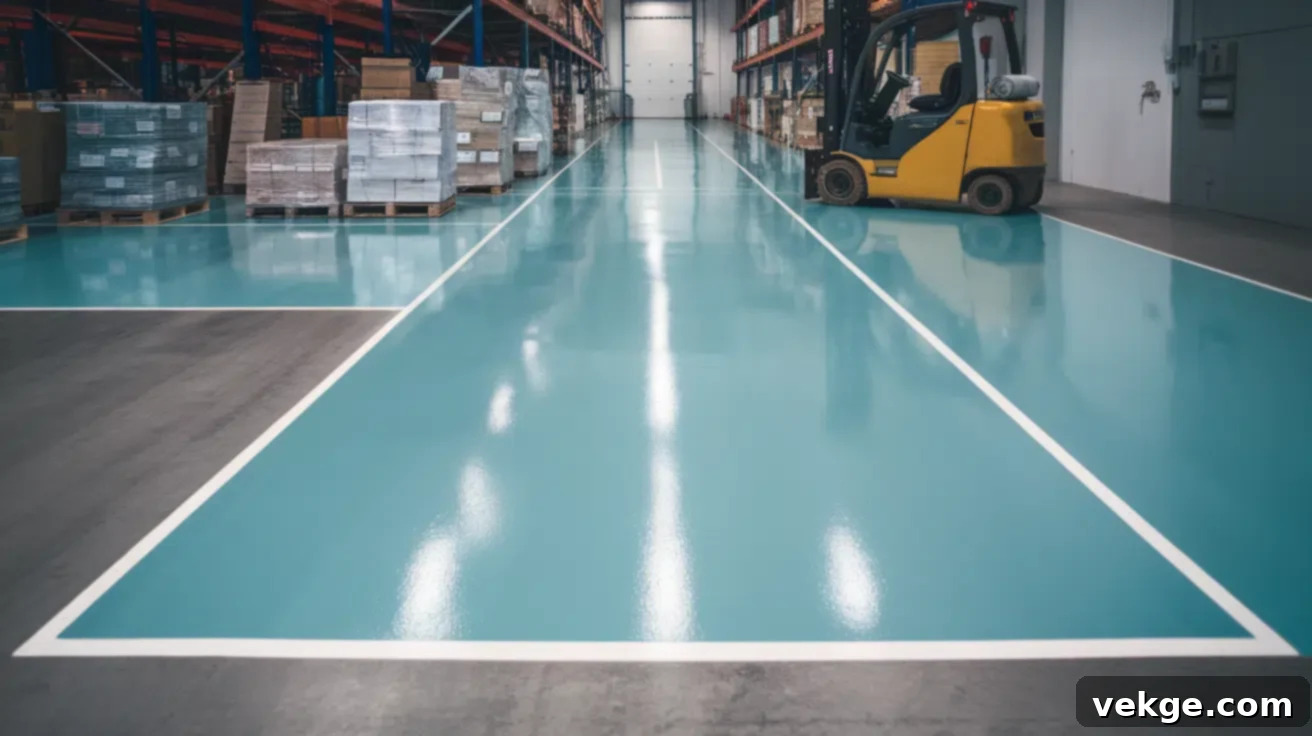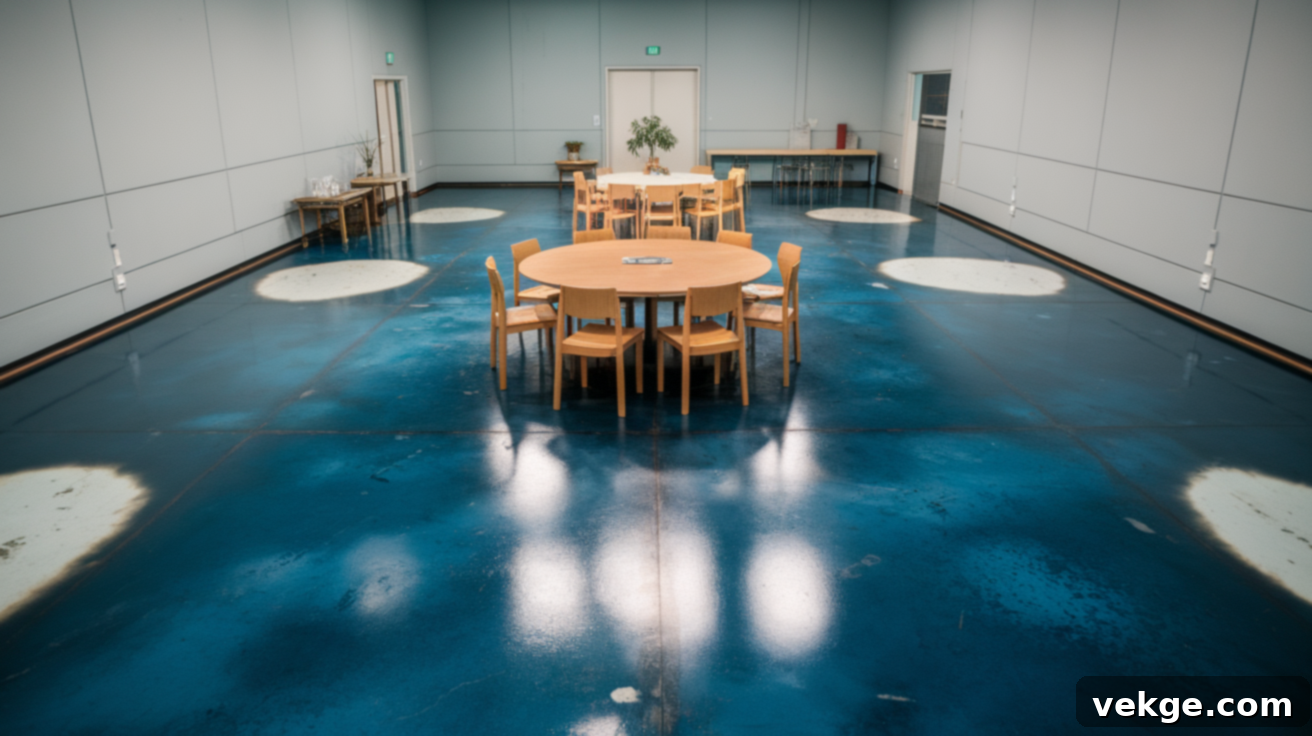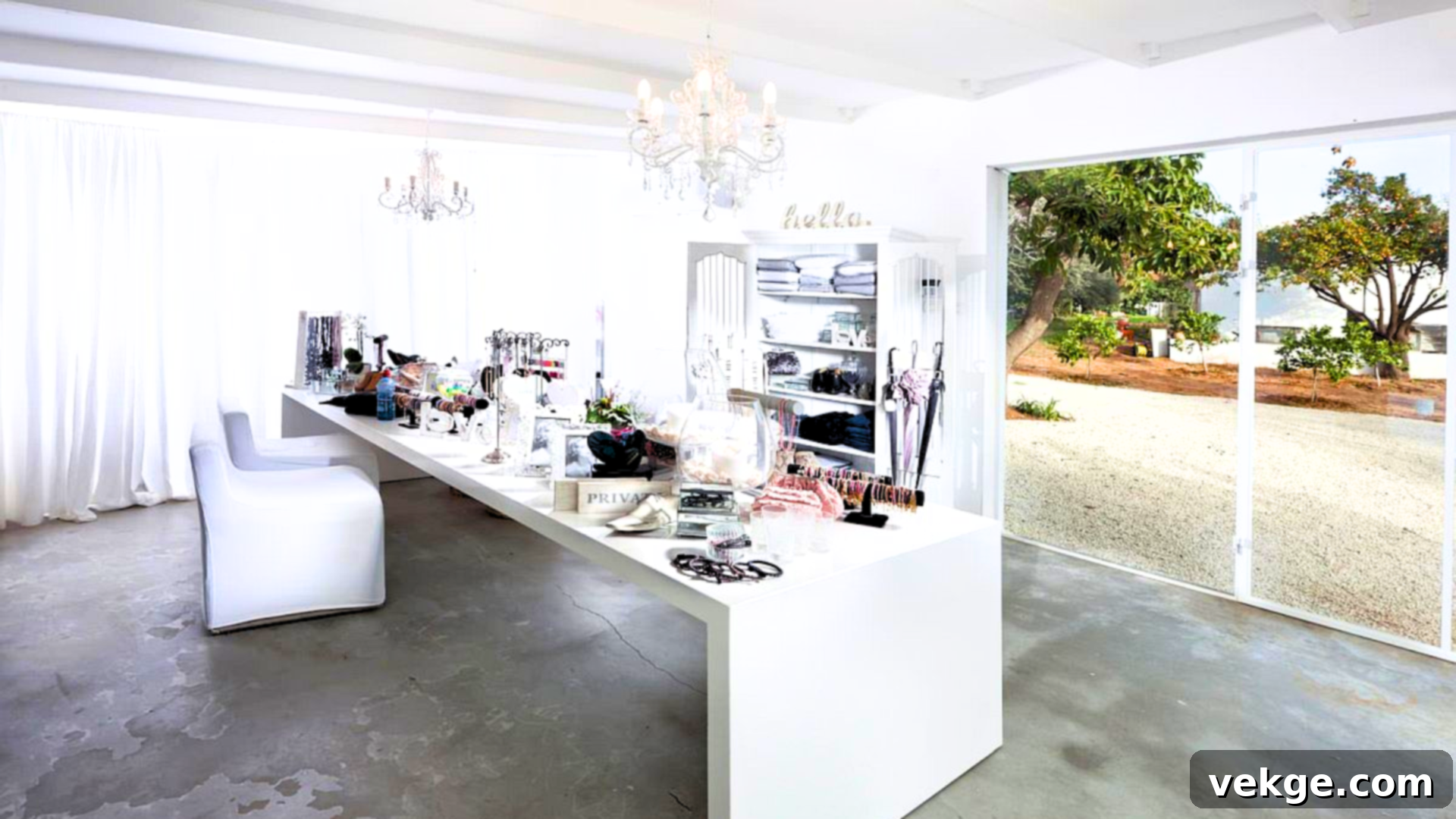The Ultimate Guide to Commercial Concrete Flooring: Durability, Design, and Value for Your Business
In today’s fast-paced commercial environment, selecting the right flooring is a critical decision that impacts not only aesthetics but also functionality, operational costs, and long-term value. For businesses ranging from bustling retail stores and corporate offices to heavy-duty industrial facilities, commercial concrete flooring stands out as an unparalleled solution. Offering a unique blend of extreme durability, remarkable versatility, and minimal maintenance requirements, concrete floors are engineered to withstand the daily rigors of high-traffic commercial spaces. This makes them the perfect choice for companies seeking a robust and reliable floor that can effortlessly handle constant wear and tear while maintaining a professional appearance.
This comprehensive guide will delve into the diverse world of commercial concrete flooring. We’ll explore the various types available, highlight their specific benefits, walk you through the installation process, and provide essential tips for selection and maintenance. Our goal is to equip you with the knowledge to make an informed investment, ensuring your business space not only looks exceptional but also performs optimally for decades to come.
Types of Commercial Concrete Flooring Finishes
Choosing the appropriate type of commercial concrete flooring finish is paramount, as it directly influences your business’s operational efficiency, aesthetic appeal, and budget. Each finishing option brings distinct advantages to the table, designed to meet specific functional and design requirements. Understanding these differences is key to making a strategic investment that perfectly aligns with your commercial needs and enhances your overall business environment.
1. Polished Concrete

Polished concrete transforms ordinary concrete slabs into high-gloss, mirror-like surfaces that are both stunning and exceptionally functional. This process involves a series of grinding and honing steps with progressively finer diamond abrasives, followed by the application of a penetrating chemical densifier. The densifier hardens the concrete, making it more resistant to abrasion and improving its longevity. The result is a smooth, light-reflective surface that can significantly reduce the need for artificial lighting, leading to lower energy costs. This finish not only enhances the brightness of a space but also makes it appear larger and more open, contributing to a more inviting atmosphere.
Ideal for a wide array of commercial applications, polished concrete is a favorite in retail spaces, high-end showrooms, modern office environments, and even restaurants where visual impact and cleanliness are paramount. Its sleek, professional appearance leaves a lasting impression on customers and employees alike, fostering a positive and sophisticated business atmosphere. Available in various sheen levels—from a subtle satin to a brilliant high-gloss—polished concrete offers unparalleled design flexibility. Businesses can achieve the exact aesthetic their brand requires, all while benefiting from a floor that is incredibly durable, low-maintenance, and resistant to stains and dust. Furthermore, polished concrete floors do not harbor allergens or dust mites, making them an excellent choice for businesses prioritizing indoor air quality.
2. Epoxy Coatings

Epoxy coatings provide a heavy-duty, protective layer that chemically bonds with the concrete substrate, creating an incredibly tough and seamless surface. This bond ensures exceptional adhesion and durability, making epoxy floors resistant to a wide range of industrial challenges. They are specifically engineered to handle harsh conditions, including frequent oil spills, aggressive chemical splashes, heavy impact from machinery, and the constant traffic of forklifts and other equipment. By filling the natural pores and imperfections of concrete, epoxy coatings create a non-porous surface that effectively prevents the harboring of bacteria, mold, and mildew, as well as the absorption of stains. This makes them an optimal choice for environments with stringent hygiene requirements.
Epoxy flooring is indispensable in manufacturing facilities, automotive repair shops, aircraft hangars, warehouse environments, and commercial kitchens. Its robust nature delivers a virtually indestructible surface capable of withstanding the most demanding daily operations while maintaining its protective properties and professional appearance. Beyond their functional benefits, epoxy coatings offer significant aesthetic flexibility. They are available in a vast spectrum of colors, allowing for custom designs, demarcation lines for safety, and branding elements. Additionally, anti-slip additives can be incorporated to enhance safety in wet or oily conditions, providing peace of mind in high-risk environments. With proper installation, epoxy floors can last for many years, offering a cost-effective and highly functional flooring solution.
3. Stained or Dyed Concrete

Stained or dyed concrete unlocks a vast world of color and artistic expression for commercial spaces, allowing businesses to customize their floors far beyond the traditional gray while preserving concrete’s inherent durability and structural integrity. This decorative option is perfect for businesses looking to make a visual statement, enhance brand identity, or create a unique ambiance.
There are primarily two types of staining processes:
- Acid Stains: These reactive stains penetrate the concrete surface and create rich, variegated, translucent tones by chemically reacting with the free lime in the concrete. The results are often mottled, earthy colors like browns, terra cottas, greens, and blues, reminiscent of natural stone. Acid stains produce permanent, weather-resistant coloration that will not peel, chip, or fade over time, making them ideal for both interior and exterior commercial applications where a natural, aged look is desired.
- Water-Based Stains (Dyes): Unlike acid stains, water-based stains and dyes do not rely on a chemical reaction. Instead, they consist of pigments suspended in a water or solvent carrier that penetrate the concrete surface to impart color. This method offers a much broader spectrum of colors, including vibrant reds, yellows, and purples, providing more consistent and predictable coverage. Water-based options are often easier to apply and can be layered or mixed to achieve unique custom hues and effects. They are excellent for creating intricate designs, logos, or patterns on the floor. Both staining methods require a protective sealer application after the color is set to enhance durability, protect against abrasion, and make the floor easier to clean and maintain. Stained concrete is a popular choice for retail stores, restaurants, lobbies, and creative office spaces seeking a blend of aesthetic appeal and robust performance.
4. Base Concrete Slabs for Commercial Spaces

While the previous categories describe aesthetic and functional finishes, the underlying concrete slab forms the essential foundation for nearly all commercial flooring projects. This foundational element is what ultimately supports the weight of equipment, foot traffic, and the entire structure. The process of installing a base concrete slab involves meticulously pouring and finishing a mixed concrete solution over a carefully prepared surface to create a strong, level, and long-lasting subfloor. This initial phase is critical to the longevity and performance of any subsequent flooring treatment.
Installation begins with thorough site preparation, which includes grading the land to ensure proper drainage, compacting the sub-base (soil or aggregate) to prevent settling, and installing a robust vapor barrier to protect against moisture intrusion. Reinforcement materials, such as rebar or wire mesh, are then strategically placed within the pour area to significantly enhance the slab’s tensile strength and crack resistance. Once the site is fully prepped and forms are set, the concrete is poured in sections, carefully leveled using screed boards, and then finished with specialized tools like floats and power trowels to achieve a smooth, dense, and clean surface. This meticulously prepared base slab provides the perfect canvas for various commercial concrete finishes, from polished and epoxy to stained, ensuring optimal adhesion and performance for the chosen topcoat.
Commercial Concrete Flooring Installation Process
Understanding the installation timeline and steps for commercial concrete flooring is essential for effective business planning and setting realistic expectations. This isn’t a quick DIY project; it’s a multi-stage, carefully orchestrated process that demands precision, expertise, and adequate time to ensure a high-quality, long-lasting result. Proper installation is critical to maximizing the lifespan and performance of your concrete investment.
- Step 1: Site Preparation & Demolition (1-5 Days)
The project begins with thorough site preparation. This involves clearing the area of any existing flooring materials, performing necessary excavation work to achieve the correct elevation, and meticulously preparing the sub-base foundation. The sub-base, typically compacted soil or aggregate, must be stable, level, and well-drained. Installation of vapor barriers is crucial at this stage to prevent moisture from wicking up through the concrete slab, which can cause significant problems later with finishes or other flooring types. - Step 2: Utility Installation & Reinforcement (2-7 Days)
Before concrete placement, all necessary utilities, drainage systems, electrical conduits, and insulation are installed and properly secured. This is also the stage where reinforcement materials are laid out. Depending on the structural requirements and expected load, this could include steel rebar grids, welded wire mesh, or even fiber reinforcement mixed directly into the concrete batch. These elements provide tensile strength and help prevent cracking. - Step 3: Concrete Pouring & Finishing (1-3 Days per Section)
With the sub-base and reinforcement ready, the concrete is poured. This step requires careful coordination, often involving multiple concrete trucks and skilled crews to ensure continuous placement. The fresh concrete is then meticulously leveled using screed boards, followed by floating to bring “cream” to the surface, and power troweling to create a dense, smooth, and durable finish. The specific finishing techniques will depend on the intended final floor type (e.g., a rougher finish for an epoxy base, or a smoother finish for polishing). - Step 4: Curing Process (7-28 Days)
Concrete curing is arguably the most critical stage for achieving the material’s full strength and durability. Curing involves maintaining adequate moisture and temperature conditions for a specified period, allowing the concrete to hydrate fully. This can be achieved through methods like wet curing (misting, wet coverings) or membrane curing (applying a liquid curing compound). While light foot traffic might be permissible after 24-48 hours, the concrete typically reaches its specified strength (and is ready for heavy loads or final finishes) between 7 to 28 days. Rushing this stage significantly compromises the concrete’s long-term performance. - Step 5: Surface Treatments & Finishing (3-10 Days)
Once the concrete has adequately cured, the desired surface treatments and decorative finishes are applied. This includes polishing, applying epoxy coatings, staining or dyeing, or other specialized applications. The timing of these treatments is crucial; for example, polished concrete requires specific curing windows to achieve optimal results, while epoxy coatings need a dry, prepared surface. This stage adds the final aesthetic and protective layers to your commercial floor.
Total Project Timeline: Most commercial concrete flooring projects typically take anywhere from 2 to 6 weeks from initial site preparation to the completion of the final finish. This duration is highly dependent on several factors: the overall size of the area, the complexity of the design, the specific type of finish chosen, access to the site, and prevailing weather conditions. It’s important to allocate ample time in your project schedule; attempting to rush the process often leads to compromised quality, potential defects, and ultimately, a less durable investment. Planning for adequate time protects your investment and ensures a superior, long-lasting commercial floor.
How to Choose the Right Commercial Flooring for Your Business
Selecting the optimal commercial concrete flooring solution requires a thorough assessment of your specific business needs, operational demands, and long-term objectives. A strategic approach ensures you invest in a floor that not only looks great but also performs flawlessly under pressure and contributes positively to your bottom line. Here are key considerations:
- Assess Traffic and Load Requirements: Evaluate your daily foot traffic patterns, the type and weight of equipment used (e.g., forklifts, pallet jacks), and any potential static or dynamic loads. This will determine the necessary durability and strength for your flooring. A retail space requires different resilience than a heavy manufacturing plant.
- Budget and Long-Term Value: Balance the initial investment cost against the long-term maintenance expenses, expected lifespan, and overall return on investment (ROI). While some concrete finishes might have a higher upfront cost, their unparalleled durability and minimal maintenance often result in significant savings over their 25-50+ year lifespan, making them a more cost-effective choice in the long run.
- Aesthetics and Brand Alignment: Consider how the flooring will support and enhance your visual branding. Explore various colors, finishes (glossy, matte, textured), and customization options (logos, patterns) that align with your company’s image and create the desired atmosphere for your customers and employees.
- Safety and Regulatory Compliance: Industry standards and local regulations often dictate specific requirements for commercial flooring, particularly concerning hygiene, slip resistance, fire ratings, and chemical resistance. Ensure your chosen flooring option meets all necessary safety protocols and compliance standards to avoid penalties and ensure a safe working environment.
- Environmental Impact and Sustainability: Concrete is inherently a sustainable material, often sourced locally, and its long lifespan reduces the need for frequent replacement, minimizing waste. Consider finishes that further enhance sustainability, such as those that improve light reflectivity, reducing energy consumption.
- Maintenance Capabilities: Factor in your team’s ability and resources for maintenance. Concrete floors are generally low-maintenance, but specific finishes (e.g., polished vs. epoxy) may have slightly different cleaning routines or re-sealing schedules.
Concrete Flooring vs. Other Commercial Flooring Types
When evaluating various commercial flooring options, concrete consistently stands out for its superior durability, long-term value, and adaptability. While other materials have their place, understanding their limitations compared to concrete can solidify your decision. The table below provides a concise comparison:
| Flooring Type | Initial Cost | Durability | Maintenance | Lifespan | Best For | Key Pros | Key Cons |
|---|---|---|---|---|---|---|---|
| Concrete | Medium-High | Excellent | Very Low | 25-50+ years | Industrial, Retail, Office, Warehouses | Extremely durable, low maintenance, customizable, hygienic, long lifespan, eco-friendly | Higher upfront cost (for finished systems), can feel cold, can be hard underfoot (addressed with mats) |
| Tile (Ceramic/Porcelain) | High | Excellent | Medium | 15-20 years | Healthcare, Restaurants, Restrooms | Water resistant, easy to clean, various designs | Expensive grout maintenance, can crack, slippery when wet, cold |
| VCT (Vinyl Composition Tile) | Low | Good | High | 10-15 years | Schools, Offices, Retail (budget-focused) | Affordable, easy installation, wide color range | Requires frequent waxing/buffing, shows scuffs/scratches easily, less durable under heavy loads |
| Hardwood/Engineered Wood | Very High | Good | High | 15-25 years | Upscale Offices, Boutiques | Premium appearance, refinishable, warm feel | Very expensive, susceptible to water damage, scratches easily, high maintenance, not for heavy traffic |
| Carpet Tiles | Medium | Fair | High | 5-10 years | Offices, Libraries, Conference Rooms | Comfortable, excellent sound absorption, easy to replace individual tiles | Stains easily, traps allergens, frequent vacuuming/cleaning required, short lifespan, not water-resistant |
As the table illustrates, while other options might offer specific advantages in niche applications, commercial concrete flooring generally outperforms them across critical metrics such as durability, lifespan, and long-term maintenance costs. This makes it an exceptionally wise investment for most commercial settings.
Design & Customization Options for Commercial Concrete
Beyond its inherent strength, commercial concrete flooring truly shines in its remarkable range of design and customization possibilities. This allows businesses to create a unique and impactful environment that perfectly aligns with their brand identity and aesthetic vision. The versatility of concrete transforms it from a mere structural component into a powerful design element.
- Finishes: Choose from a spectrum of finishes including ultra-glossy (polished concrete), sophisticated matte, or practical textured surfaces (ideal for slip resistance). Each finish can dramatically alter the feel and function of a space.
- Color: Concrete can be dyed or stained in an almost limitless palette of colors, from subtle earth tones to vibrant, bold hues. This allows for intricate patterns, color blocking, or even replicating the look of other materials.
- Decorative Cuts & Engravings: Saw cuts can be strategically placed to create geometric patterns, mimic tile or large slab designs, or simply add visual interest. Advanced techniques allow for engraving logos, custom artwork, or wayfinding elements directly into the concrete surface.
- Aggregates & Overlays: Different aggregates (like glass, marble chips, or metal shavings) can be exposed during the polishing process for a terrazzo-like effect. Decorative overlays can be applied to create unique textures or patterns, even over existing, less attractive concrete.
- Inlays & Logos: Business logos, brand motifs, or artistic inlays can be seamlessly incorporated into the floor design, providing a powerful branding opportunity right underfoot.
- Metallic & Decorative Epoxy: For a truly striking visual, metallic epoxy coatings create a three-dimensional, swirling effect with pearlescent pigments, mimicking flowing water, molten metal, or abstract art. These are particularly popular in high-end retail and entertainment venues.
These extensive options ensure that a concrete floor not only meets rigorous performance standards but also acts as a fundamental component of your interior design, enhancing the overall visual appeal and creating a memorable experience for anyone entering your commercial space.
Maintenance & Longevity Tips for Commercial Concrete Flooring
One of the most compelling advantages of commercial concrete flooring is its incredibly low maintenance requirement, which significantly contributes to its long-term cost-effectiveness. However, adhering to a simple, consistent maintenance routine is crucial to preserving its pristine appearance, maximizing its lifespan, and ensuring it continues to perform optimally for decades. Neglecting basic care can lead to premature wear and potential damage.
- Daily Cleaning:
- Sweep or Dust Mop: Daily sweeping or dust mopping is essential to remove loose dirt, dust, and debris. This prevents abrasive particles from scratching the surface, particularly for polished or sealed concrete. Use a soft-bristle broom or a microfiber dust mop for best results.
- Weekly Cleaning:
- Damp Mop: Weekly damp mopping with a neutral pH cleaner is usually sufficient to keep concrete floors clean. Avoid harsh, acidic, or alkaline cleaners, as these can strip sealers or damage the concrete surface over time. For epoxy floors, a mild degreaser might be used for oil and grease.
- Monthly/Quarterly Deep Cleaning:
- Auto Scrubber: For larger commercial spaces, using an auto scrubber with a neutral cleaner and appropriate pads can efficiently perform deep cleaning. Ensure the pads are compatible with your specific concrete finish (e.g., softer pads for polished concrete).
- Spot Cleaning: Address specific stains or high-traffic areas with targeted concrete cleaners designed for the particular type of stain (oil, rust, grease, etc.).
- Immediate Spill Cleanup:
- Act Quickly: Always clean spills immediately to prevent staining, especially for unsealed or less protected concrete. Liquids like oil, chemicals, or food items can penetrate the surface if left for too long. Blot spills rather than wiping to avoid spreading.
- Sealing/Re-sealing Schedule:
- High-Traffic Areas: Re-seal every 1-2 years. These areas experience constant wear and tear, necessitating more frequent protection.
- Moderate Traffic Areas: Re-seal every 2-3 years.
- Low-Traffic Areas: Re-seal every 3-5 years.
- Signs for Re-sealing: Look for signs of dullness, increased porosity (water no longer beads on the surface and soaks in), or visible wear patterns. A good sealer protects against abrasion, chemical attack, and moisture.
- Common Damage & Repair:
- Small Cracks: Minor cracks can often be fixed with a suitable concrete crack filler or epoxy injection. Ensure the filler matches the floor’s color and texture as closely as possible.
- Stains: Utilize specialized concrete stain removers specific to the type of stain. For persistent stains, grinding and re-polishing or re-coating might be necessary.
- Surface Wear/Dullness: For polished concrete, light re-polishing or applying a fresh protective topcoat can restore shine. For coated floors, a new topcoat or a full re-application might be required.
- Chips/Spalls: Chips and spalls can be repaired with a matching concrete patching compound or epoxy repair kit. The area must be thoroughly cleaned and prepped for proper adhesion.
- Preventative Measures:
- Entry Mats: Place robust mats at all entrances to trap dirt and moisture, significantly reducing the amount of abrasive debris carried onto the floor.
- Furniture Pads: Use felt or rubber pads under heavy furniture or equipment to prevent scratches and gouges.
- Regular Inspections: Periodically inspect your concrete floor for any early signs of wear or damage, addressing them promptly to prevent escalation.
By diligently following these maintenance and longevity tips, your commercial concrete floor will not only retain its aesthetic appeal but also continue to provide superior performance and durability for decades, making it a truly wise and enduring investment for your business.
Conclusion: A Smart, Sustainable Investment for Your Business
Commercial concrete flooring truly represents a smart, long-term investment for any business seeking a high-performance, aesthetically versatile, and cost-effective flooring solution. Its unmatched durability, requiring minimal ongoing maintenance, makes it an ideal choice for the most demanding commercial environments—from the relentless activity of warehouses and bustling retail stores to the professional ambiance of modern office spaces.
While the initial investment for a high-quality finished concrete floor might appear significant, its impressive lifespan of 25 to 50+ years, combined with remarkably low upkeep requirements, translates into substantial long-term value and considerable savings over its lifetime. Unlike other flooring options that demand frequent replacement or extensive repair, concrete floors are built to last, offering unparalleled resilience against wear, impact, and chemical exposure.
Furthermore, the extensive design and customization options available—through polishing, epoxy coatings, staining, and decorative elements—ensure that a concrete floor can be tailored to perfectly align with your brand identity and enhance the overall aesthetic of your commercial space. It adapts to your specific needs, offering the reliability, performance, and visual appeal necessary to keep your operations running smoothly and impress your clientele.
Ultimately, choosing commercial concrete flooring is a strategic decision that delivers peace of mind, operational efficiency, and a lasting foundation for your business’s success. It’s an investment you won’t regret, providing a floor that is as robust as it is beautiful.
Ready to explore more ways to optimize your business environment? Check out my other blogs for additional tips and insights on making your commercial space work better for you.
